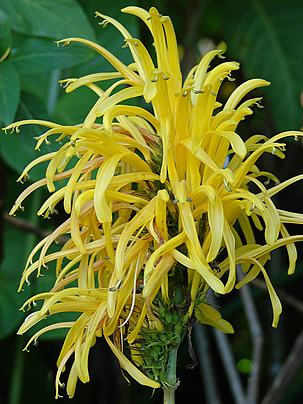The Yellow Jacobinia (Justicia aurea) is a woody and floriferous shrub, native to coastal regions of Central America and Mexico. In its natural habitat, it can reach up to 20 feet (6 meters) in height, although in cultivation, it typically grows to around 8.2 feet (2.5 meters). Its branches are pubescent to tomentose when young, and sparsely branched.
The leaves of the yellow jacobinia are simple, opposite, ovate to elliptic, acuminate, glossy, with well-marked veins, and crenulate margins. It blooms throughout the year, with more intensity in spring and summer. Its inflorescences are spike-like, dense, erect, composed of numerous tubular flowers with yellow corollas that are highly attractive to hummingbirds.
The yellow jacobinia stands out for its large and showy inflorescences that form throughout the year. Additionally, with its broad leaves and loose texture, it imparts a tropical feel wherever it is used. It can add charm to a shaded corner in the garden, along walls, or placed individually in entrances, balconies, etc.
It can also be planted near columns, trained as if it were a climber with some support. The yellow jacobinia thrives in indoor environments that receive plenty of direct light, such as under skylights or close to windows. In this case, plant it in large pots to allow for proper root development.
It should be cultivated in semi-shaded areas with fertile soil enriched with organic matter, and irrigated regularly. It does not tolerate drought or intense cold, especially in frost-prone areas. In coastal areas, cultivate under full sun. It appreciates a tropical climate with warmth and humidity most of the time but does not tolerate prolonged waterlogging.
Prune the yellow jacobinia at the end of winter to stimulate branching and foliage renewal. Take this opportunity to fertilize the plant with slow-release fertilizers. During flowering, it is advisable to remove old flowers to encourage the formation of new buds. Propagation is done by cuttings that are rooted after flowering, typically during the pruning period.


